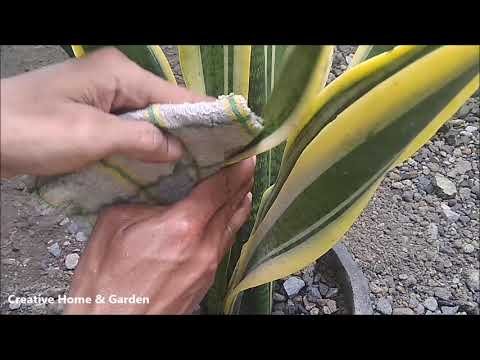Distribution & Habitat
Sansevieria is a group of about 70 species, varying greatly from succulent desert plants like Sansevieria pinguicula to more thin-leaved tropical plants like Sansevieria trifasciata. An evergreen perennial plant native to Iran, Iraq and Africa, Sansevieria forms dense stands, spreading by creeping root systems, some of which are above ground, some below. From the basal rosette, the leaves grow vertically. Sansevieria trifasciata has stiff blade-like leaves. They are yellow-banded on the outside and green on the inside. Mature leaves are dark green with light gray-green cross-banding, and typically range from 70–90cm (28–35 inches) in length and 5–6cm (2.0–2.4 inches) wide.
Description
This Sansevieria variety is becoming more commercially important, as its leaves are grown for their hemp-like fiber. These plants are attractive and tough enough to survive in pots and are very tolerant to a wide range of conditions. A plant of Sansevieria trifasciata Laurentii will grow slowly but last more than a decade.
Proper Care
These plants require low maintenance, are easy to grow, and are recommended as plants contributing to air quality improvement in living and working spaces. A variety of conditions are tolerant to the Sansevieria trifasciata ‘Laurentii’. This species is very drought tolerant and can tolerate light conditions of up to 60% shade.
Light
Tolerant of light levels ranging from 250 lux to 2,000 lux, but they do best in medium light levels of 400–800 lux (partial shade).
Water
Despite being drought tolerant, Sansevieria trifasciata Laurentii is an excellent houseplant. A Sansevieria plant is known to be tolerant of low humidity, water, and feeding, as well as growing root bound.
Keep the soil dry between waterings. During the winter season, water the soil only once a month, or whenever it feels dry to the touch. During the growing season, the plants need to be irrigated every other week. The foliage of the plants is given only enough water during the winter months to prevent wilting. The soil should be watered so the leaves will not rot from being watered (overhead watering).
A Sansevieria trifasciata Laurentii plant must not sit in water or else it will rot. The biggest danger is overwatering, especially during the winter months. When the leaves turn yellow or become soft and mushy at the base, it means that Sansevieria trifasciata Laurentii has been over watered. Most Sansevieria trifasciata Laurentii problems occur when the plant is over-watered.
Temperature
Place Sansevieria trifasciata Laurentii in a warm spot since they are cold-sensitive. However, they can tolerate fluctuating temperatures as long as they are not exposed to adverse weather conditions. The Sansevieria trifasciata Laurentii is harmed by temperatures below 10oC (50oF). The ideal temperature for Sansevieria trifasciata Laurentii is 21 to 32oC (70-90oF).
Soil
A potting mix with adequate drainage. They’ll thrive in sandier soils.
Fertilizer
During the growing season, feed a mild cactus fertilizer; do not fertilize in the winter.
Potting and Repotting
Only divide plants when they need repotting in the spring. An underground mass of shoots on a well-grown Sansevieria trifasciata Laurentii can split an earthenware pot. It is best to keep the rosette of the leaves at soil level when repotting it. Sansevieria trifasciata Laurentii like cactus potting mix. Make sure the container is wide, heavy and flat. For this tall plant, use a heavy and wide container to prevent toppling.
Propagation
Plants can be propagated by division or leaf-cuttings up to 2 inches long may be used for propagation. These cuttings form roots after about a month in sandy soil. Then they form a long stolon-like bud which is distant from the cutting which produces the new plant.
It is very easy to divide Sansevieria trifasciata Laurentii because many of its roots have shallow roots. Simply pull out the entire plant by turning the pot on its side. Each clump should be potted separately by cutting through the thick roots with a sharp knife.
Problems
Watch for mealybugs and spider mites. Overwatering causes root rot. No serious insect or disease problems.
Uses
Both floor standing and table top plants can be used with Sansevieria trifasciata Laurentii.
As an accent potted plant or as part of a grouping in a planter or garden bed, Sansevieria trifasciata Laurentii works equally well. There are many places, including hospitals, hotels, shopping malls, banks, and homes, where Sansevieria trifasciata Laurentii is a popular and popular ornamental plant. It adds color, texture, and drama to any environment.
Many Sansevieria species are believed to work well as air purifiers due to their ability to remove toxins from the air (such as formaldehyde, xylene and toluene), so they are believed to offer good treatment for sick building syndrome. During the night, Sansevierias utilize the crassulacean acid metabolic process to absorb carbon dioxide and release oxygen. This is purported to make them suitable bedroom plants. Sansevieria usually is not recommended for bedrooms since its leaves can be poisonous if ingested.w
The NASA researchers found that agar absorbs toxins, including nitrogen oxides and formaldehyde. Sansevieria is capable of absorbing 107 different types of toxins, including air pollution, cigarette smoke (nicotine), so it would indeed be helpful for re-energizing you after an exhausting day.
The leaves of Sansevieria grow upward, so according to feng shui, the plants can be used for feng shui purposes.
______________________________________________________________________________________________________________________________
There are still many recent and interesting articles about Snake Plants..
..as well as other unique information from All Things Gardener..
For further information and other inquiries..
..you can contact us here

